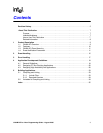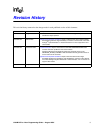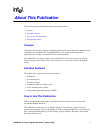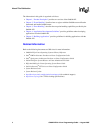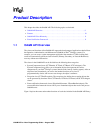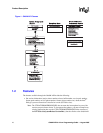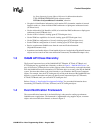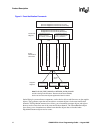
OA&M API for Linux Programming Guide — August 2005 11
Product Description
for Linux Operating Systems Library Reference for information about the
CTPLATFORMVERSIONINFO data structure and the
ICTNode::GetSystemReleaseVersionInfo( ) function.
• Get physical identification information (serial number, PCI slot number, number of network
interface trunks, etc.) about individual DM3 architecture or Springware architecture boards
(ICTBoard class).
• Get the Addressable Unit Identifier (AUID) of an individual DM3 architecture or Springware
architecture board (ICTBoard class).
• Get the AUID of a board’s clocking agent (ICTClockAgent class).
• Get the TDM bus capabilities of a board's clocking agent (ICTClockAgent class).
• Get the TDM bus configuration of a board's clocking agent (ICTClockAgent class).
• Set the TDM bus configuration of a board’s clocking agent (ICTClockAgent class).
• Receive asynchronous OA&M events from the event notification framework
(DlgAdminConsumer class).
• Instantiate event handler objects. Event handler objects are invoked when DlgAdminConsumer
objects receive events from the event notification framework (CEventHandlerAdaptor class).
1.3 OA&M API Class Hierarchy
The System Component classes of the OA&M API (CCTDomain, ICTNode, ICTBoard, and
ICTClockAgent) are organized into a hierarchy as shown in Figure 1, “OA&M API Classes”, on
page 10. Since the CCTDomain class resides at the top of the class hierarchy, each application built
from the OA&M API must first instantiate a CCTDomain object as an entry point into the OA&M
system. You must then adhere to the class hierarchy as you instantiate other System Component
objects. For example, since the ICTClockAgent class resides at the bottom of the OA&M API class
hierarchy, you must instantiate and query all other System Component objects (CCTDomain,
ICTNode, ICTBoard) until you reach the ICTClockAgent class.
Refer to Chapter 4, “Application Development Guidelines” for procedural information about
instantiating CCTDomain, ICTNode, ICTBoard, and ICTClockAgent objects.
1.4 Event Notification Framework
The event notification framework is the Intel
®
Dialogic subsystem for sending asynchronous
OA&M events to applications. The framework is implemented using supplier objects, consumer
objects and event notification channels as shown in Figure 2:



